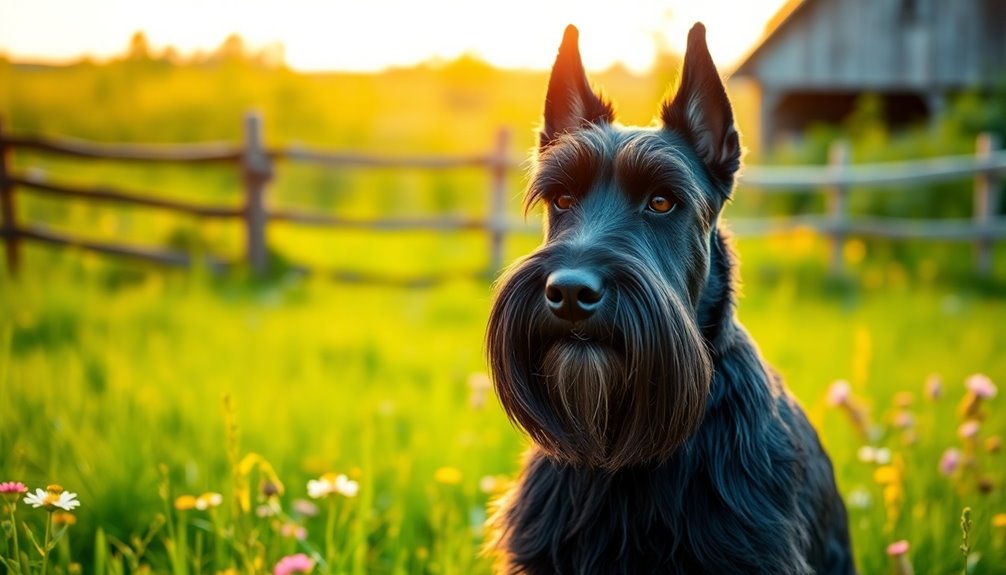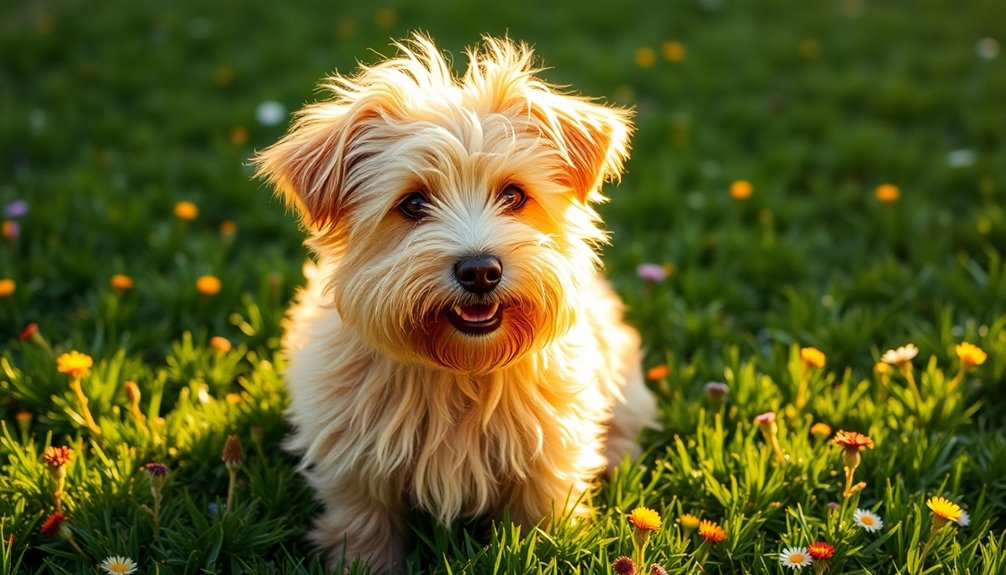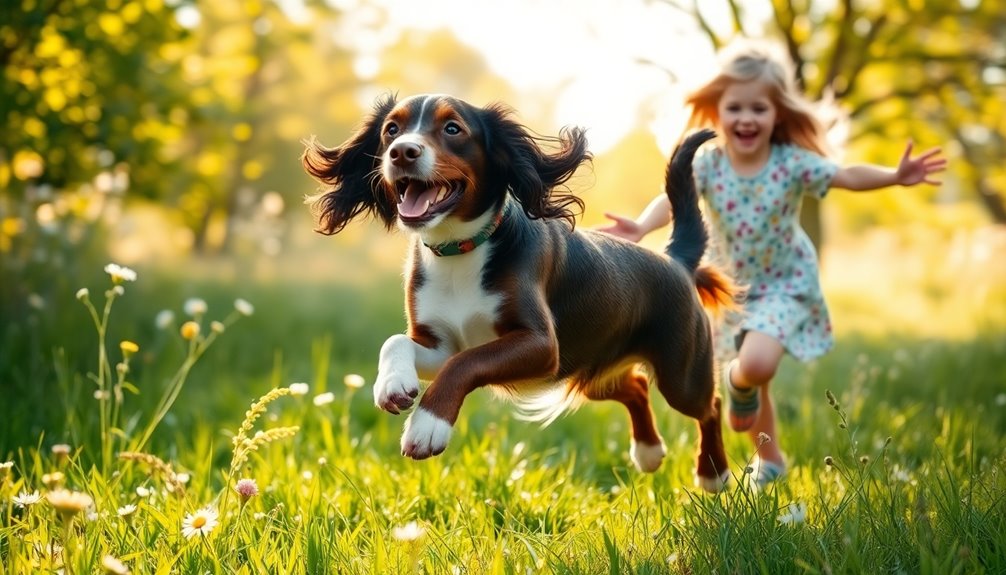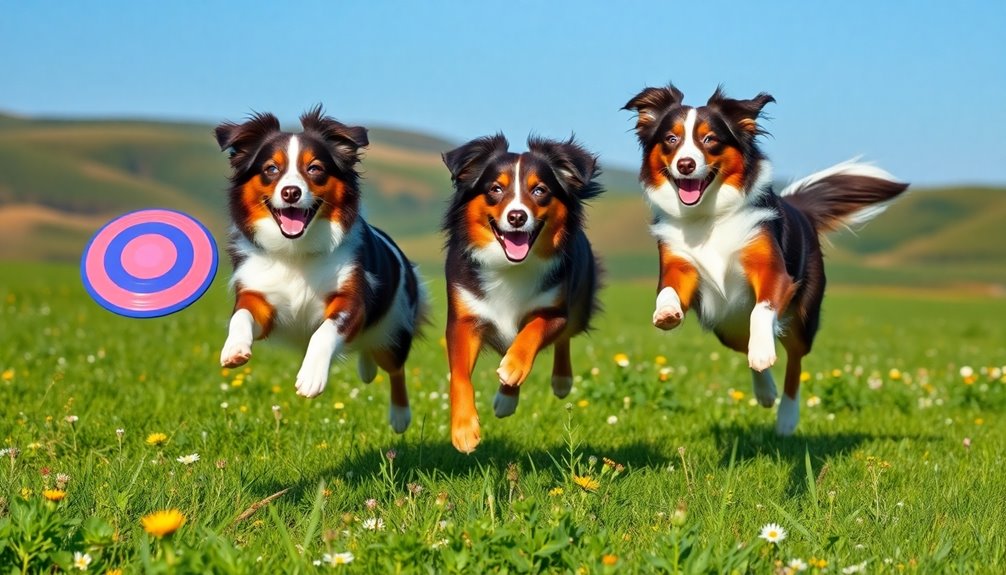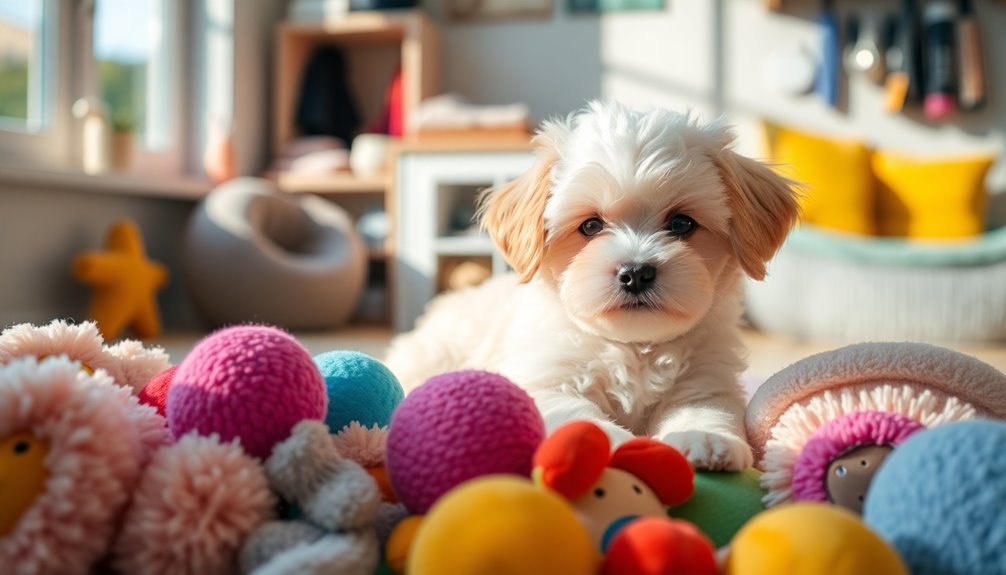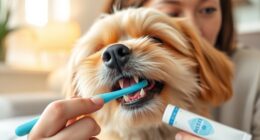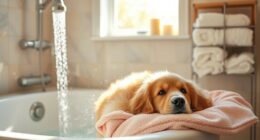If you're looking for a versatile and loyal working dog, the Standard Schnauzer could be perfect for you. Standing 17 to 20 inches tall, this breed is intelligent and requires regular exercise. Their protective nature makes them excellent watchdogs, while their playful character ensures they bond well with families. These dogs thrive on mental stimulation and consistent training, which helps manage their strong-willed tendencies. Plus, their hypoallergenic coat means less shedding, making them suitable for allergy sufferers. Curious about how to best care for and train this unique breed? There's so much more to discover!
Key Takeaways
- The Standard Schnauzer, originating from Germany, was bred for versatile roles including protecting livestock and controlling vermin on farms.
- With a height of 17 to 20 inches and a weight of 30 to 45 pounds, they are adaptable working dogs suitable for various environments.
- Known for their intelligence and loyalty, they excel as watchdogs, providing protection and companionship to families.
- Their hypoallergenic, low-shedding coat allows them to be suitable for allergy sufferers while participating in dog sports.
- Regular exercise and mental stimulation are vital, as they require 60-80 minutes of activity daily to stay happy and healthy.
Introduction
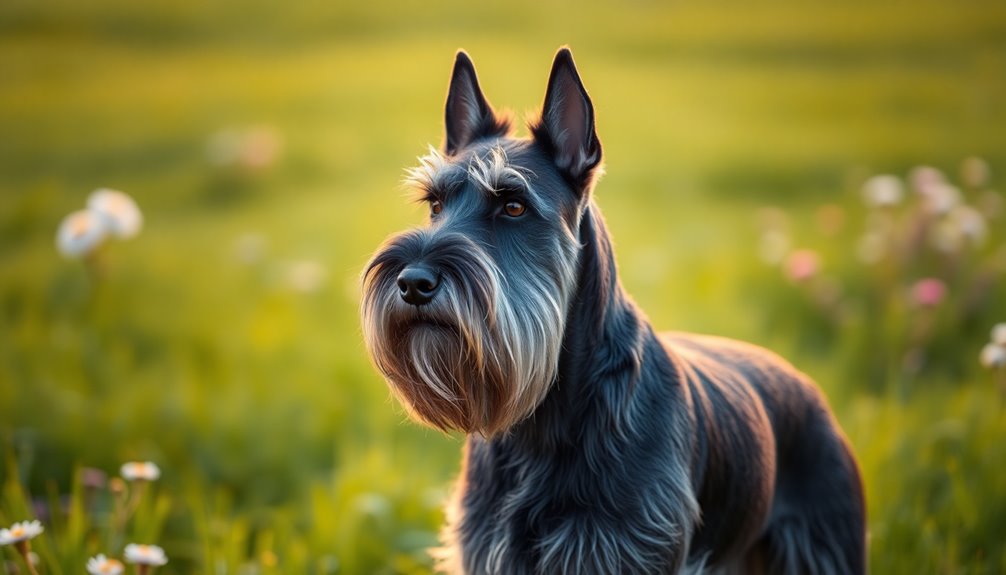
The Standard Schnauzer is a remarkable breed known for its versatility and loyalty, making it a standout choice for families and working environments alike. Standing between 17 to 20 inches tall and weighing 30 to 45 pounds, this breed combines strength and agility with a distinctive appearance. Their stiff, wiry coat comes in pepper and salt or pure black, giving them a unique look that catches the eye.
Schnauzers are high-spirited and intelligent, often dubbed the "dog with the human brain." Their loyalty makes them excellent watchdogs, ensuring your family feels secure. However, they require active owners who can match their energy levels, needing over 30 minutes of exercise daily. Regular walks and playtime are essential to keep them mentally stimulated, as they have a high energy level that demands regular physical activity.
Grooming is another key aspect of their care; they require frequent professional grooming or regular maintenance at home to keep their coat in top shape. Early socialization and training are critical, as these dogs can be stubborn without proper leadership.
With a lifespan of 12 to 16 years, the Standard Schnauzer can be a long-term companion, bringing joy and protection to your home.
History and Origin
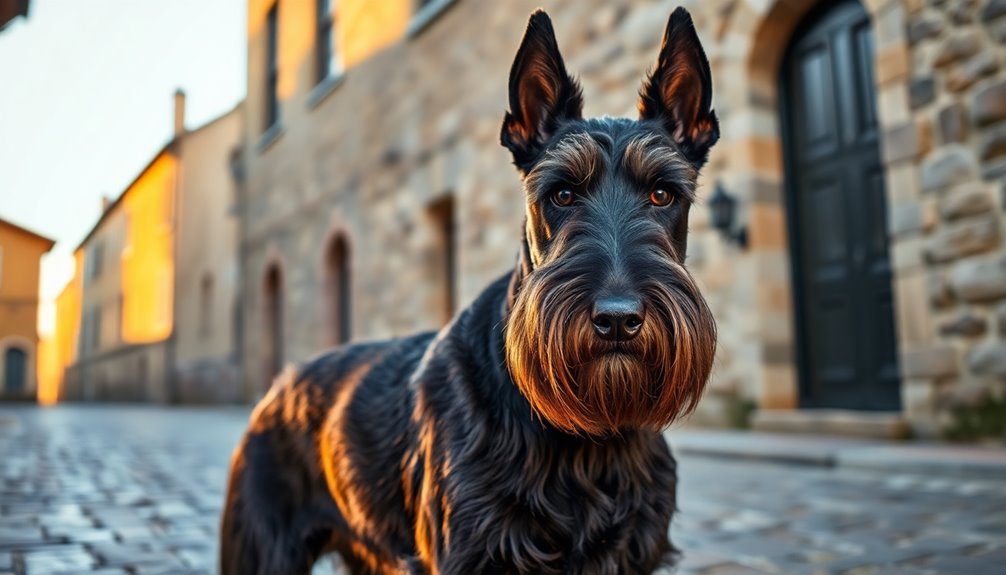
You'll find that the Standard Schnauzer traces its roots back to 15th and 16th century Germany, where it first served as a reliable farm dog. Its primary roles included protecting livestock and controlling vermin, showcasing its versatility. This breed's lineage reflects a strong connection to working environments, making it an invaluable companion on farms. The breed's ancestry is linked to European herding and guardian breeds, further emphasizing its working background.
Where and when the breed originated
Originating in Germany, the Standard Schnauzer has roots that trace back to the 15th and 16th centuries. This breed was specifically developed in Western Europe as both a household companion and a working dog, reflecting the agricultural and herding needs of the time. All Schnauzers have grooming needs due to their double coat, requiring care every 5-8 weeks.
You can find early depictions of Schnauzers in artwork from this era, including pieces by Albrecht Dürer, which highlight their significance in German culture.
The first verifiable records of the breed appear in literature and art from 1492 to 1504, marking at least 50 years of selective breeding to establish its unique characteristics.
Early ancestors of the Standard Schnauzer include various European herding and guarding breeds, notably the German Pinscher, and possibly the black German Poodle and gray Wolfspitz. They also share lineage with Wire-Haired Pinschers and the German Black Standard Poodle.
The name "Schnauzer" comes from the German word "Schnauze," meaning "snout." Initially referred to as Wire-Haired Pinschers, these dogs gained official breed recognition in the late 19th century and were first imported to the United States in the early 1900s.
Ratting and Farm Protection
Throughout history, Standard Schnauzers have played a crucial role in ratting and farm protection. Bred specifically to chase away rodents and rabbits, these dogs were vital in safeguarding stored grains and fields from pests.
You'd find them wandering independently through the fields, effectively controlling vermin without much human intervention. Their thick whiskers helped protect them from bites as they hunted. Genetic studies indicate that their unique coat features arise from the dominant R-spondin-2 gene and Agouti Signaling Protein (ASIP) gene.
In addition to pest control, Standard Schnauzers excelled as farm guardians. They protected livestock and the farmer's family, especially during trips to markets. Their medium size made them versatile; they fit well in a farmer's cart while still being formidable protectors.
They also safeguarded merchandise for tradesmen traveling between towns. These dogs performed multiple roles on family farms, from hunting vermin to guarding livestock, showcasing their intelligence and energy.
During wartime, their loyalty and ability to follow commands were recognized as they served as dispatch carriers and guard dogs for the German Army in World War I.
Physical Characteristics
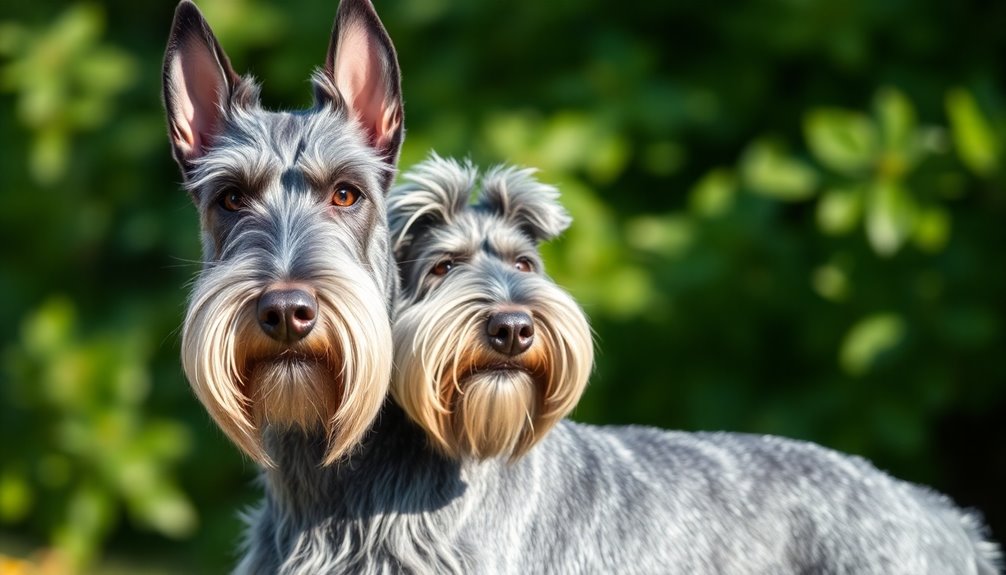
When you look at a Standard Schnauzer, you can't help but notice their compact and sturdy build, with males standing 18.5 to 19.5 inches tall and females slightly shorter. Their distinctive double coat, which can be pepper and salt or pure black, requires regular grooming to keep it in top shape. Don't forget their expressive faces, highlighted by bushy eyebrows and a charming beard that adds to their unique character. This breed typically weighs between 30 to 50 lbs, making them a medium-sized dog that is both robust and agile.
Size, weight, and coat details
The Standard Schnauzer stands out with a height ranging from 18.5 inches for females to 19.5 inches for males at the shoulder. Overall, you can expect their height to fall between 23 to 26 inches (58 to 66 cm), with a withers height of 18 to 20 inches (44 to 50 cm).
In terms of weight, males can weigh up to 50 pounds, while females can reach up to 45 pounds. Typically, their average weight ranges from 31 to 44 pounds (14 to 20 kg), and a Standard Schnauzer puppy at 8 weeks will weigh around 9 to 10 pounds.
Their coat is a distinctive double coat, featuring a wiry outer layer and a dense, softer undercoat. It's medium in length, lying close to the body—neither bristly nor wavy.
You'll notice that the hair on their legs is less harsh, while the forehead and ears have shorter hair. The acceptable coat colors include Pepper and Salt, as well as Black. The Pepper and Salt coloration showcases a mix of black and white hairs, with shades ranging from dark iron gray to silver gray. Standard Schnauzers require extensive grooming to maintain their distinctive appearance, which includes twice-weekly combing and quarterly trimming.
Regular grooming is essential, requiring twice-weekly combing and quarterly trimming.
Beard and Bushy Eyebrows
One of the most striking features of the Standard Schnauzer is its beard and bushy eyebrows, which contribute significantly to its unique appearance. The arched eyebrows, along with a bristly mustache and whiskers, are hallmark characteristics that define this breed. These features, part of the dog's wiry outer coat, not only enhance its distinguished look but also serve a functional purpose.
Historically, the beard and eyebrows provided protection for the muzzle while the Schnauzer worked as a ratter, creating a thick shield against bites and scratches from vermin. The breed's intelligent and athletic nature allows it to excel in various tasks beyond just being a ratter.
Regular grooming is essential to maintain the beard and eyebrows, as they tend to get dirty quickly. You'll need to clean the beard frequently and trim the hair around the eyes and mouth to prevent matting.
The AKC breed standard emphasizes the importance of these features, noting the desirable pepper-and-salt coloration that may fade to light gray or silver in the facial hair. A darker facial mask should harmonize with the coat color, making the beard and eyebrows integral to the breed's overall appearance.
Keeping them well-groomed ensures your Standard Schnauzer remains both functional and visually striking.
Temperament and Personality
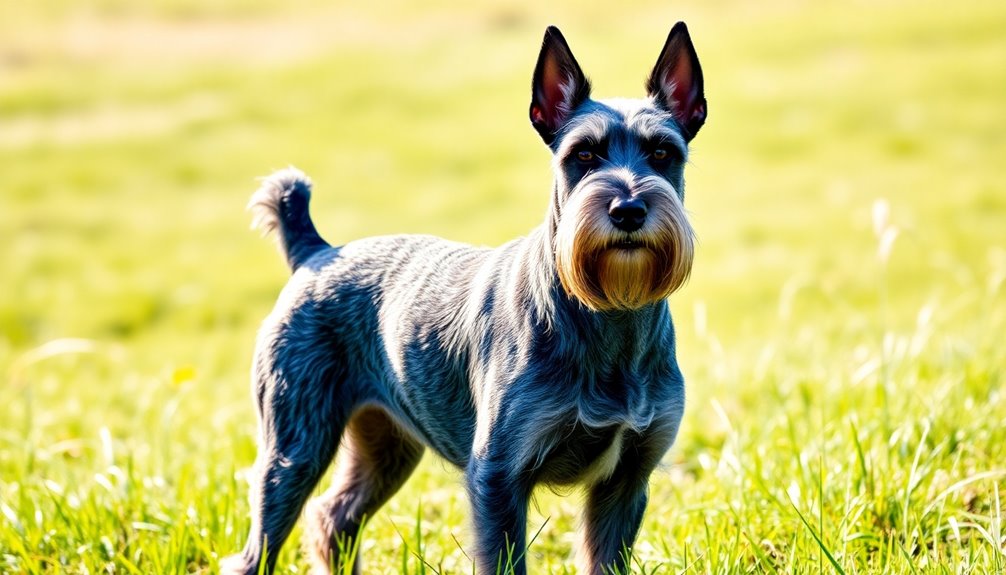
When you think about the Standard Schnauzer, you'll find a playful and protective companion that's perfect for families, individuals, or even other pets.
Their loyalty and energy make them great playmates for kids, while their watchful nature ensures your home stays secure. With the right socialization, they can adapt well to various living situations, making them versatile additions to any household. Their high energy level means they require significant mental and physical stimulation to keep them happy and healthy.
Playful and Protective Nature
Embodying a delightful mix of playfulness and protective instincts, Standard Schnauzers stand out as versatile companions. These energetic dogs thrive on regular exercise and love engaging in lively play. Their mischievous nature makes them fun to be around, and they often seek out mental challenges, enjoying tasks like obedience, agility, and herding. With their intelligence and trainability, they can quickly master new commands and tasks, which enhances their ability to engage with their families.
You'll find that they thrive best in active environments where they can have a job or contribute around the house.
On the protective side, Standard Schnauzers are natural guardians. Their alertness and watchfulness help them quickly react to potential threats, making them effective watchdogs.
They're fiercely loyal to their families, and their vocal nature serves as a deterrent to intruders. With proper training, they can distinguish between genuine threats and benign situations, ensuring you feel secure without unnecessary barking.
Suitability for families, individuals, or other pets
Standard Schnauzers are an excellent choice for families, individuals, or those with other pets due to their friendly and adaptable nature. They're affectionate and love being involved in family activities, making them great companions for children. Their size is ideal, striking a balance that keeps both kids and the dog safe.
However, they require plenty of exercise and mental stimulation to prevent boredom, so be ready for an active lifestyle. Their high energy levels necessitate consistent exercise and mental stimulation, so be prepared to engage them regularly.
For individuals, their intelligence and eagerness to please make training a breeze, although they can be a bit stubborn. They need regular exercise and can be strong-willed, especially when young. Socialization is crucial, as they may be standoffish with strangers but are loyal protectors of their loved ones.
When it comes to other pets, Standard Schnauzers have a strong prey drive, so introducing them to smaller animals requires care. They generally do well with larger pets if properly socialized. Just be cautious with small breeds, as they might bully them.
Health and Lifespan
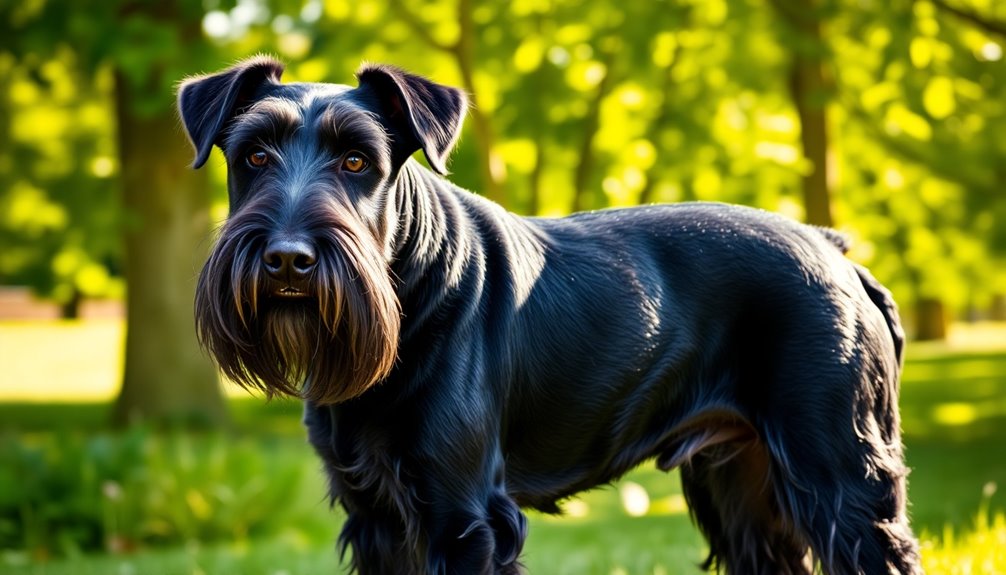
When you consider the health and lifespan of a Standard Schnauzer, you'll notice they typically live between 12 to 16 years, depending on their care and genetics. However, like any breed, they can be prone to certain health issues, such as hip dysplasia and heart disease. Staying proactive with regular check-ups and preventive care can help ensure your Schnauzer leads a healthy, vibrant life. Additionally, it's crucial to be aware that Standard Schnauzers are susceptible to various eye problems, which can significantly affect their quality of life if not addressed early.
Typical lifespan of the breed
The typical lifespan of a Standard Schnauzer ranges from 13 to 16 years, making them a notably long-lived breed for their size. While some sources may estimate a slightly shorter lifespan of 11 to 14 years, this breed generally enjoys robust health, reflecting their strong genetic background and overall vitality.
Several factors can influence how long your Schnauzer lives. Proper nutrition tailored to their life stage is crucial, as is regular veterinary care and check-ups to catch any potential issues early. Daily exercise of at least one hour is recommended to help maintain their health and prevent obesity.
Adequate exercise appropriate for their age helps maintain a healthy weight and joint health, while preventive healthcare measures, like vaccinations and parasite control, are essential for longevity.
Additionally, mental stimulation and emotional well-being are important. Engaging your Schnauzer socially and providing mental challenges can prevent behavioral problems and promote a happier life.
Don't overlook dental hygiene, as it can prevent systemic diseases that may affect their overall health. With a balanced diet and an active lifestyle, you can help maximize your Standard Schnauzer's lifespan and ensure they thrive as a loyal companion.
Common health concerns or genetic predispositions
While a Standard Schnauzer enjoys a relatively long lifespan, it's important to be aware of common health concerns and genetic predispositions that can impact their quality of life.
Hip dysplasia is a significant issue, leading to joint problems and potentially degenerative diseases. Eye problems like cataracts and dry eye are also common, especially in older dogs.
You should be mindful of dilated cardiomyopathy, a serious heart condition that can be detected through a DNA test. Hemophilia A, an inherited blood clotting disorder, can complicate surgeries.
Pulmonic stenosis may cause serious heart-related symptoms, including fainting and breathing difficulties.
Metabolic and endocrine issues such as pancreatitis, diabetes, and hypothyroidism can occur as well. Regular monitoring is essential to manage these conditions effectively. Additionally, maintaining a healthy weight can reduce the risk of these metabolic issues.
Other concerns include epilepsy, various cancers, and urinary tract stones. Skin issues like sebaceous cysts and follicular dermatitis may also arise, necessitating proper care.
Tips for maintaining health and wellness
Maintaining your Standard Schnauzer's health and wellness involves a combination of proper diet, regular exercise, grooming, and routine veterinary care.
Start with a balanced diet, providing high-quality dog food formulated for medium-sized breeds. Aim for 1-2 cups of dry food daily, split into two meals, and opt for low-fat options to prevent weight gain. Additionally, ensure that your Schnauzer's diet is rich in proteins and vitamins to support their overall health. Incorporating anti-inflammatory foods can also benefit their overall wellness.
Regular exercise is crucial for your Schnauzer's moderate to high energy level. Take daily walks for at least 20 minutes, three times a day or two 30-minute sessions. Incorporate playtime with fetch, frisbee, or agility training, and engage their mind with interactive games.
Grooming helps maintain their coat and hygiene. Brush your Schnauzer 2-3 times a week to avoid matting, and schedule professional trims every 6-8 weeks. Bathe them monthly using oatmeal-based shampoos, and don't forget regular nail trims and ear cleanings.
Finally, prioritize routine veterinary check-ups annually for early health issue detection. Establish a consistent oral hygiene routine, monitor their weight, and ensure fresh water is always available. Regular vet visits can help identify any potential issues early, promoting a longer lifespan for your Schnauzer.
Care Requirements
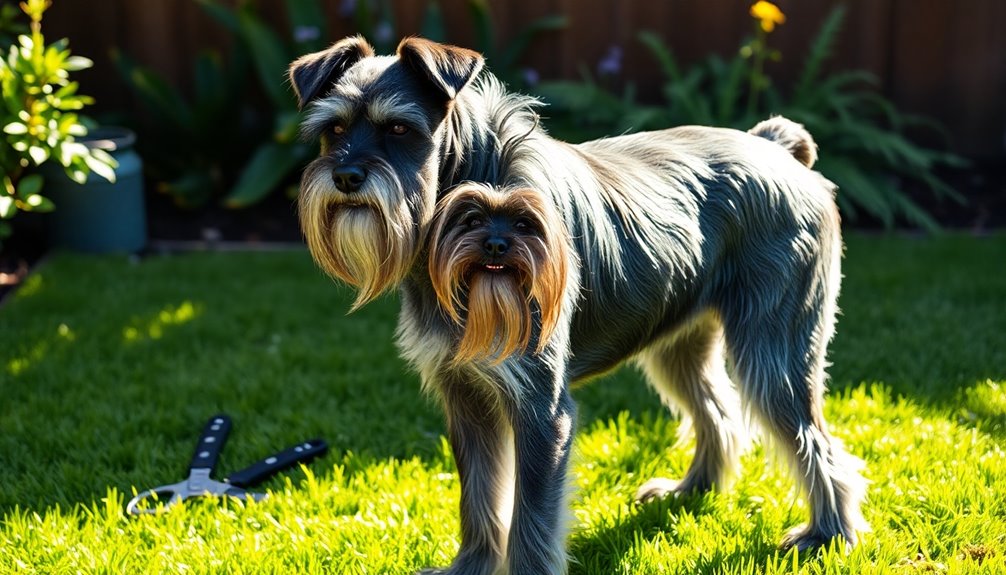
Caring for your Standard Schnauzer involves regular brushing to keep their coat healthy and manageable. Additionally, it's important to note that the Schnauzer has a double-coat which requires special attention during grooming to maintain its integrity. You'll also need to ensure they get plenty of exercise to match their energy levels and prevent boredom. Additionally, paying attention to their diet is crucial for maintaining their overall health and vitality.
Regular Brushing Required
Regular brushing is essential for keeping your Standard Schnauzer's coat healthy and looking its best. You'll need to brush your dog at least twice a week to maintain its wiry outer coat and denser undercoat. For effective brushing, use a pin brush, bristle brush, or slicker brush. A medium-toothed comb is recommended specifically for your Schnauzer's legs and face.
During the transition from puppy to adult coat, which typically occurs between ages 1 and 15 months, daily brushing is advisable. This helps prevent matting and tangling, ensuring your dog stays comfortable and stylish. Regular brushing is particularly important because the double-coated breed has both an undercoat and a top coat that require attention.
Standard Schnauzers have minimal shedding, making them great for allergy sufferers, but their wiry outer coat needs regular maintenance. You'll also want to wipe their beard regularly to reduce odors and discoloration.
Don't forget to trim the hair between the toes and around the paws, as well as the eyebrows, beard, and mustache. Nail clipping or grinding should be done every one to two weeks, along with ear cleanings to prevent infections.
Regular brushing not only keeps their coat in shape but also helps your Schnauzer get accustomed to grooming.
Exercise requirements and energy levels
A well-groomed Standard Schnauzer isn't just about a tidy coat; it also requires ample exercise to thrive. You should aim for 60 to 80 minutes of daily physical activity. This can include brisk walks, engaging play sessions, agility training, or fetch games.
Ideally, take your Schnauzer for one or two walks a day, ensuring they maintain a brisk pace to elevate their heart rate. Parks are fantastic for off-leash play, but make sure your dog has good recall.
Don't forget about mental stimulation, which is just as crucial. Incorporate puzzle toys and interactive games to keep boredom at bay and prevent behavioral issues like barking or digging. Engaging activities should include muscle strengthening and mental engagement to promote overall well-being.
Tailor these activities to your dog's age and energy level to keep them engaged. As a high-energy breed, your Standard Schnauzer needs at least 30 minutes of activity each day.
Meeting both their physical and mental exercise needs is essential for their happiness and well-being. Neglecting exercise can lead to anxiety and destructive behavior, so involve your family in their activities.
Feeding tips and diet recommendations
When it comes to feeding your Standard Schnauzer, striking the right balance in their diet is key to keeping them healthy and energetic.
For puppies, choose high-calorie food with 18-25% protein, 10-15% healthy fats, and feed smaller meals three to four times a day. You should provide half to one full cup daily, based on their age and expected weight.
As they grow into adults, aim for a diet with 28-32% protein and 8-12% fat. High-quality animal proteins like beef, chicken, and fish are vital. Schnauzers are known for their intelligence and versatility, which makes them adaptable to various roles, including as working dogs.
For older dogs, serve three-quarters of a cup of senior-formulated food daily, ensuring around 400 kilocalories.
Monitor their weight regularly to avoid obesity, adjusting portions gradually as needed. Some Schnauzers may require special diets due to skin allergies or hip dysplasia, so consider hypoallergenic options if necessary.
Feeding twice daily works well for adults, while puppies benefit from multiple smaller meals.
You might also include daily probiotics and joint supplements, but always consult your veterinarian for personalized advice.
Keeping these tips in mind will help you provide the best nutrition for your Schnauzer.
Training and Socialization
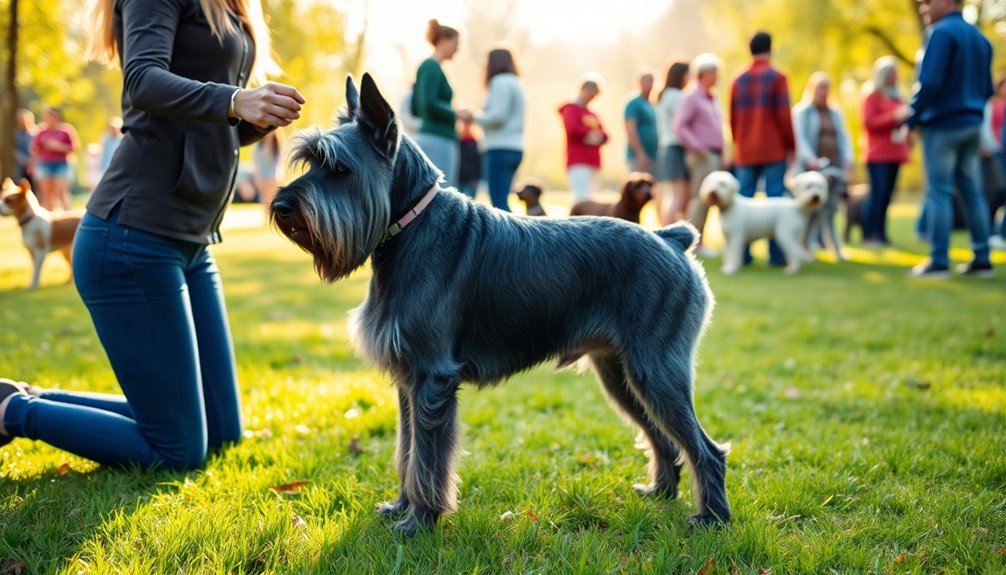
When it comes to training your Standard Schnauzer, remember they're intelligent and eager to please, which makes them quick learners. Gradual introductions to new environments will help them adapt and reduce any leash reactivity or impulse control issues. Consistency among family members is essential for effective learning in your training approach.
Intelligent and Eager to Please
Recognizing the Standard Schnauzer's intelligence and eagerness to please can significantly enhance your training experience. These dogs respond exceptionally well to consistent and positive training methods, making them highly trainable.
You'll find that they learn quickly, excelling in obedience, agility, herding, and even therapy roles. Start teaching basic commands like 'sit', 'stay', and 'come' early, as early training sets the foundation for a well-behaved dog.
Using positive reinforcement techniques is crucial. Rewarding your Schnauzer with treats or praise for correct behavior will motivate them to engage. Regular exposure to various environments and people can also support early socialization, which is critical for their behavior development.
Keep your tone firm yet gentle when giving commands, as this approach fosters trust and respect. Short, engaging training sessions are vital for maintaining their focus, so mix things up to keep them interested.
Gradual Introductions to New Environments
Training and socialization go hand in hand, especially for a breed like the Standard Schnauzer that thrives on both mental stimulation and interaction with the world around them. To ensure your Schnauzer adapts well to new environments, start by introducing them gradually.
Begin with familiar areas before venturing into new spaces. Daily walks are essential—aim for at least one long walk and several shorter play sessions to help them adjust. It's important to remember that early socialization plays a crucial role in overcoming timidity and enhancing confidence.
When exploring new locations, engage your Schnauzer with activities like hikes or visits to parks. These experiences not only provide physical exercise but also encourage mental engagement.
Incorporate puzzle toys and training exercises to keep boredom at bay, especially in unfamiliar settings. As you introduce new environments, make sure to use fenced areas for off-leash activities, ensuring safety and preventing them from straying.
Positive reinforcement is crucial; whenever your Schnauzer exhibits calm behavior in a new environment, reward them with treats or praise. This approach builds confidence and reduces anxiety, creating a well-rounded and adaptable companion.
Leash Reactivity and Impulse Control
Leash reactivity can be a common challenge for many dog owners, especially with breeds like the Standard Schnauzer that are naturally energetic and alert.
To tackle this, start training in a quiet environment where distractions are minimal. Use positive reinforcement—reward your dog with treats or praise when they respond correctly or ignore triggers. Implement the "Auto Watch" technique, teaching your Schnauzer to turn away from distractions and focus on you instead. Establishing clear leadership and structure in your training sessions can also help reduce anxiety and improve behavior.
As your dog gets comfortable, gradually increase distractions. If necessary, consider using a head halter for better control, but introduce it carefully to avoid discomfort.
Impulse control exercises are equally important. Practice the "Stay" exercise, where your dog remains in place while you walk away. Incorporate "Wait for Food," "Door," and "Toy" exercises to reinforce self-control in various situations.
Consistency is key; ensure everyone in your household uses the same commands and methods, and avoid punishment as it hinders progress.
Finally, choose the right leash and collar for safety and control, and don't hesitate to consult a professional trainer for severe reactivity issues.
Ideal Living Environment

When considering a living environment for your Standard Schnauzer, a house with secure fencing is ideal to keep them safe while they play. They thrive best in moderate climates, so think about how temperature fluctuations might affect their comfort. With the right setup, your Schnauzer can enjoy a happy and active life. Additionally, they adapt well to apartment living, making them suitable for various housing situations.
House With Secure Fencing
Creating a secure environment for your Standard Schnauzer involves not only having a sturdy fence but also ensuring it meets specific needs. A fence height of at least 5-6 feet is crucial, as these energetic dogs can jump higher than you might expect. Consider adding a rolling top or anti-climbing features to deter their athletic nature. Lean-in extensions and coyote rollers can also prevent them from scaling the fence.
To tackle their moderate digging tendencies, bury the lower edge of the fence 12-24 inches deep. Installing metal strips or large rocks below the surface creates a solid barrier against digging. Regularly inspect your fence line for new dig holes to maintain security. Ensure there are no gaps or openings too small for your Schnauzer to squeeze through. Additionally, being aware of common behavioral challenges can help you anticipate and manage any issues your Schnauzer might exhibit.
Furthermore, take into account that certain breeds may require specific designs to effectively manage their natural instincts. Solid fencing, like vinyl panels, minimizes climbing risks and reduces visual stimulation that can lead to barking. Finally, enhance security with motion-sensing lights and secure latches on gates.
Landscaping with dense shrubs can deter intruders and improve your yard's aesthetics, creating a safe haven for your loyal companion.
Prefers Moderate Climate Conditions
Standard Schnauzers thrive in moderate climate conditions, making them adaptable companions for various environments. While they can comfortably handle both hot and cold temperatures, proper care is essential.
In warmer months, you'll need to keep an eye on hydration and provide sun protection, ensuring they don't overheat. Their efficient panting mechanisms help, but you'll still want to monitor their comfort. To help them adapt to warmer climates, ensure they have access to fresh water at all times.
No matter the climate, these dogs require at least an hour of exercise daily. Whether it's brisk walks, playtime, or outdoor activities like hiking, they need mental and physical stimulation to stay happy.
During extreme weather, don't forget that indoor activities, like agility training, also work wonders.
Their coarse, wiry double coat acts as insulation, but it demands regular grooming. Brushing and professional grooming every 6-8 weeks will keep their coat healthy and comfortable, especially when stripping or clipping during hotter months.
Hypoallergenic Coat Benefits

If you're considering a Standard Schnauzer, you'll appreciate its hypoallergenic coat, which makes it a great choice for allergy sufferers. Its low shedding and minimal dander mean you can enjoy various dog sports without worrying about allergens in your home. Plus, this breed even made a splash in films like 'The Artist', showcasing its versatility beyond just being a loyal companion. Additionally, the Standard Schnauzer is known for its excellent watchdog abilities, making it not only a delightful pet but also a reliable protector for your family.
Versatile in Various Dog Sports
Many dog owners appreciate the Standard Schnauzer for its exceptional versatility in various dog sports, thanks to its intelligence and athleticism. These dogs excel in obedience, agility, tracking, and even herding, showcasing their adaptability across disciplines.
In conformation rings, you'll often see them combine show and working titles, demonstrating their impressive dual skills.
When it comes to agility, Standard Schnauzers navigate obstacles like the A-Frame, Pause Table, Dog Walk, and Seesaw with ease, proving their physical prowess. Their strong tracking abilities make them ideal candidates for search and rescue, as well as bomb and drug detection work.
To keep your Standard Schnauzer engaged and happy, you should provide at least one long walk daily alongside several shorter play sessions totaling about an hour. Activities like jogging, hiking, and interactive play challenge their intelligence and physical capabilities. Their need for mental stimulation is crucial; without it, they could develop destructive behaviors. Engaging in canine competitions like rally and obedience not only fulfills their desire to work but also strengthens your bond while keeping them active and stimulated. Additionally, their shrewd intelligence allows them to quickly learn and master new skills, making training a rewarding experience for both the dog and owner.
Featured in 'The Artist' Film
Featuring prominently in the film "The Artist," the Standard Schnauzer showcases not only its charming personality but also its hypoallergenic coat benefits. If you're someone who struggles with allergies, this breed might be a perfect fit for you.
Standard Schnauzers have minimal shedding, which means less hair around your home and fewer allergy triggers. Their unique double coat consists of a wiry outer layer and a softer undercoat, effectively trapping dander and preventing it from circulating in your environment. Moreover, regular grooming can help maintain a positive environment, reducing stress levels in both the pet and owner.
By producing reduced levels of dander, these dogs help enhance your overall comfort. You can enjoy the companionship of a Schnauzer without the worry of constant allergic reactions. Additionally, their intelligence and eagerness to learn make them moderately easy to train, further enriching the experience of pet ownership.
Regular grooming, including twice-weekly brushing and monthly baths with oatmeal-based shampoos, keeps their coat healthy and minimizes potential allergens.
Moreover, their low allergenicity extends to minimal drooling, reducing saliva spread. This breed not only contributes to a cleaner indoor air quality but also fosters a harmonious coexistence between you and your furry friend.
With a Standard Schnauzer, you can embrace pet ownership while mitigating allergy concerns, making the relationship truly rewarding.
Active Lifestyle Compatibility
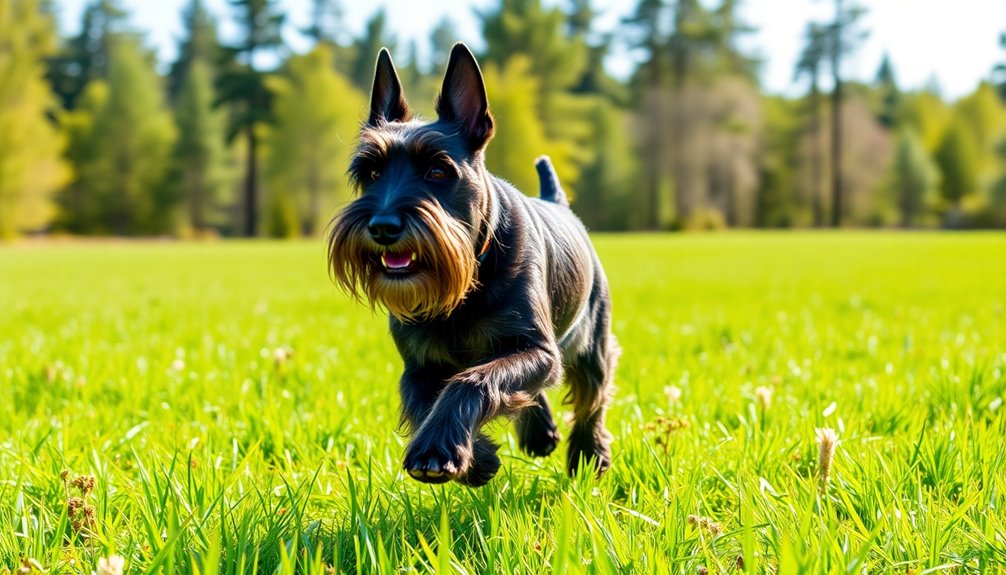
If you're looking for a family-friendly dog that can adapt to your active lifestyle, the Standard Schnauzer might be the perfect fit. They thrive on engagement and require daily exercise, making them great companions for both kids and adults. Plus, with their grooming needs manageable, you can focus more on enjoying adventures together rather than worrying about upkeep. Their historical role as farm helpers showcases their versatility and ability to integrate into various family activities. Additionally, their need for daily exercise not only keeps them physically fit but also promotes mental stimulation, which is essential for their overall well-being.
Family-Friendly and Adaptable Companion
While Standard Schnauzers thrive in active households, they also adapt well to various living situations, making them ideal family companions. Their loyal nature means they love being close to you and your family. You'll find them devoted to every member, especially young kids, thanks to their playful and loving temperament. They form strong bonds and prefer your company over isolation.
These dogs can fit into almost any home environment, whether you have a yard or live in an apartment, as long as you provide daily exercise. They tolerate different climates well, making them suitable for various locations. Even if your lifestyle isn't overly active, Standard Schnauzers only need about an hour of exercise each day, which can include walks or engaging activities like tracking or agility. Additionally, they require consistent training to help mitigate any stubbornness and ensure good behavior.
To keep them happy, ensure they receive plenty of mental stimulation to prevent boredom, which can lead to destructive behavior. Their intelligence means they learn quickly, but be ready for some stubbornness.
With proper training and socialization, they'll become the adaptable and loving companion your family needs.
Grooming Needs and Maintenance
Maintaining your Standard Schnauzer's grooming needs is essential for their health and appearance, especially for active families.
You'll want to brush your Schnauzer weekly for about 10-15 minutes, but daily brushing is ideal to prevent tangles and maintain their coat. A simple rubdown with a towel each week removes dirt and excess oils, while bathing the leg and facial furnishings at least once a month keeps them clean. Regular brushing and carding prevent tangles, making it easier to manage their harsh coat. Additionally, regular grooming helps control pet hair in your home, making it easier to manage fur accumulation.
Every 4-6 weeks, give them a full bath, washing gently in the direction of hair growth.
Use tools like a 'Detangler' rolling comb, 'Furminator', and 'Coat King' stripping tool for optimal results. A slicker brush works wonders for the furnishings, and good-quality hairdressing scissors are essential for trimming.
Don't forget to manage specific tasks, such as trimming hair from under the paws and around the ears.
Regular grooming can seamlessly fit into your active lifestyle. With an hour of exercise daily, such as walking or hiking, you can schedule grooming sessions around these activities.
Your Schnauzer will thrive with both physical exercise and proper grooming, ensuring they remain happy and healthy.
Frequently Asked Questions
What Are Common Behavioral Issues in Standard Schnauzers?
Common behavioral issues in Standard Schnauzers often stem from insufficient exercise and mental stimulation.
If you don't provide at least 30-45 minutes of daily activity, they might engage in destructive behaviors, like chewing or running through the house.
Additionally, without proper socialization, they can become territorial and bark excessively.
Stubbornness in training can also arise if you don't start early and use consistent, positive reinforcement methods.
Engaging them mentally and physically is crucial.
How Do I Choose a Reputable Breeder?
To choose a reputable breeder, start by researching breeders who belong to recognized breed clubs.
Check for their listing in referral lists and ensure they follow a Code of Ethics.
Visit the breeder's facility to observe the conditions and ask about health clearances for the puppies.
Look for transparency regarding genetic issues and request references from previous buyers.
It's crucial to ensure the breeder prioritizes the health and well-being of their dogs.
Are Standard Schnauzers Good With Children?
Yes, Standard Schnauzers can be great with children! They're patient and protective, making them loyal companions for families.
However, it's important to supervise their interactions, especially with younger kids, to prevent any rough play.
Training and socialization from an early age help them develop a well-adjusted temperament.
Involving your children in the training process can also teach respect, ensuring a harmonious relationship between your Schnauzer and your family.
What Is the Average Cost of a Standard Schnauzer?
The average cost of a Standard Schnauzer puppy typically ranges from $400 to $1,500, but it can go higher based on the breeder's reputation and the puppy's lineage.
If you're considering adopting an adult, you might find prices between $75 and $400.
Don't forget to budget for initial supplies and ongoing expenses like food, grooming, and medical care, which can significantly impact your overall costs in the long run.
Can Standard Schnauzers Adapt to Apartment Living?
Yes, Standard Schnauzers can adapt to apartment living, but you'll need to consider their size and energy levels.
They require sufficient space to move around and need at least 60-80 minutes of exercise daily.
Make sure you provide daily walks and engaging activities to keep them stimulated.
With proper training and socialization, they can thrive in an apartment, as long as you meet their physical and mental needs.
Conclusion
In conclusion, the Standard Schnauzer is a versatile and loyal companion that fits well into active lifestyles. With their unique blend of intelligence, energy, and hypoallergenic coat, they make fantastic pets for families and individuals alike. By providing proper training and socialization, you can foster a strong bond with your Schnauzer, ensuring a happy and fulfilling life together. If you're looking for a dedicated working dog that thrives on activity, this breed might just be perfect for you!

